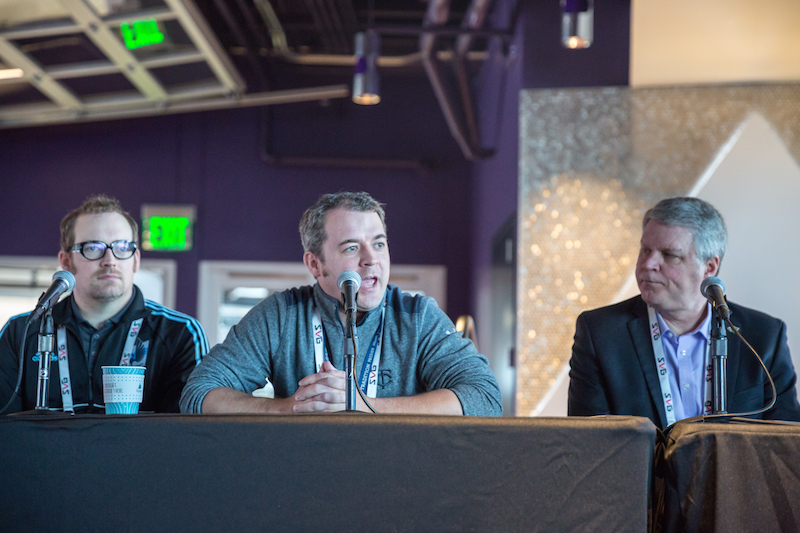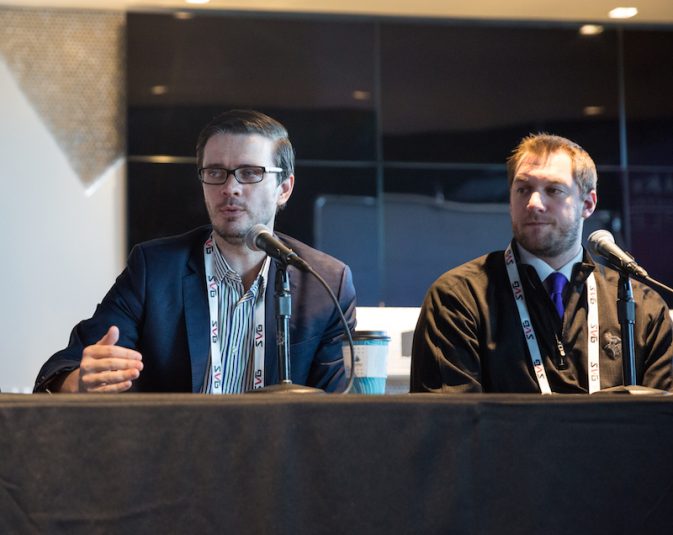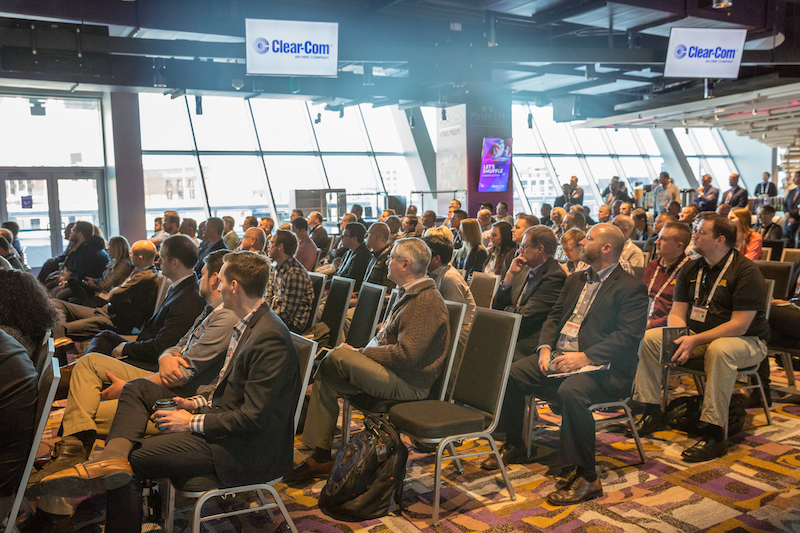Sports Venue Production Summit: How Minneapolis’s Pro Sports Teams Are Energizing Their Fans In-Venue
The Vikings, Timberwolves, Twins, Wild, and Minnesota United FC weighed in on best practices to create content
Story Highlights
As the in-venue–video experience evolves to include larger-than-life displays, concourse TVs, mobile apps, and more, the role of game-day producer is changing. At SVG’s Sports Venue Production Summit last week at U.S. Bank Stadium in Minneapolis, producers from the Vikings, Timberwolves, Twins, Wild, and Minnesota United FC weighed in on what steps they’ve taken to develop, distribute, and promote their team’s unique video strategy across a variety of platforms.
The Vikings’ Skol Chant: Creating Tradition in a New Venue
As the Vikings opened the gates to their new home, the team seized the moment to create a new identity in an effort to build an intimidating home-field advantage. The Vikings took inspiration from the Iceland national soccer team, which created a worldwide phenomenon with its Viking War Chant during the its Cinderella run at last summer’s Euro 2016 tournament. The Minnesota Vikings took this dramatic tradition and created The Skol Chant for the team’s home games at U.S. Bank Stadium.
The Vikings video-production team first heard Iceland’s Viking War Chant on ESPN’s SportsCenter. By season’s end, the Skol Chant had become as vital a component of the Vikings’ in-game traditions as the sounding of the gjallarhorn prior to kickoff.
“Moving into a new building, a big challenge is how to create tradition,” said Allan Wertheimer, senior manager, production, Minnesota Vikings. “[Iceland’s Viking War Chant] basically fell into our lap and turned into a big part of what we do at our games now. This was either going to flop or going to be very cool. Luckily for us, it turned out really well. From a tradition standpoint, it’s only year one, but, even when the stadium is not totally full, it still has a big impact. From a tradition standpoint, we hope this continues.”
Target Field: Keeping Up With the Venue-Tech Joneses
Next month, Target Field will begin its eighth season as the home of the Minnesota Twins. When the team first entered its new facility, Minnesota Twins Director, Production, Sam Henschen was focused on wiping the slate clean from the days at the Metrodome and creating a clean, streamlined videoboard show that offered focused sponsorship opportunities and the highest-quality original content possible.

From left to right, Minnesota United FC’s Brad Baker, Minnesota Twins’ Sam Henschen, and Minnesota Wild’s John Maher give tips for using video to energize the fanbase.
Today, the Twins are facing big questions regarding future technology. Equipment that was state-of-the-art at the opening of Target Field is reaching the end of its life, creating an opportunity for the Twins production team to invest in new technology.
“As an organization, we are trying to figure what to replace [in terms of equipment],” said Henschen. “What do we do for 4K? We had a 120-TB server when we moved in in 2009, and that thing is plumb full. We thought 120 TB would last us for quite a while. But now, with 4K and everything else, we aren’t even going to be close to having enough room. So, going into our eighth season, we have to start planning from a capital perspective what we need to do to take us to the next level.”
Xcel Energy Center: Getting the Most Out of Your Videoboard Real Estate
The Minnesota Wild’s Xcel Energy Center opened in 2000, and, in 2009, the team elected to upgrade the control room to HD even though the videoboards were not yet HD-capable. In 2014, the arena received a new center-hung HD videoboard that was six times the size of the previous display, along with additional LED boards throughout the bowl. The Wild’s video-production and marketing teams began plotting how to best use the abundance of new videoboard real estate at their disposal.
“We had to think about how we were going to use all those [LED boards] … and how all those new displays were going to be programmed and become a part of our game presentation,” said John Maher, VP, brand content and communications, Minnesota Wild. “Our marketing and video teams actually created a couple of new high-profile advertising spaces on our main center-hung that didn’t exist before, which created a new piece to monetize for our corporate [ad-sales] team. When we opened for Opening Day, we had all that new programmed real estate ready to go. In addition to getting the new technology, you also have to figure out how to use it.”
Target Center: Making Big Decisions on a Short Timeline
A three-phase renovation is currently under way at Target Center, home of the Minnesota Timberwolves and Lynx. In Phase 1, which began in April 2016 immediately after the end of the Timberwolves’ season, the arena received a new videoboard and audio system and a suite-level revamp. Phase 2 renovations of exterior elements have continued throughout this NBA season, with the Target Center remaining open for Wolves and Lynx games and other events. Phase 3 of the renovations will begin this summer, with major interior construction on locker rooms, concourse, public restrooms, etc.
With a massive new videoboard, halo system, corner boards, upper-level displays, and more, the Target Center video-production team was tasked with laying out a content strategy on a very short timeline.
“We had a very small window: the board was built in three weeks, and then we had five days with the board in the air before the Lynx returned to play on national television,” said Chadwick Folkstead, executive producer, live programming and entertainment, Minnesota Timberwolves. “So some of our content was being displayed on the boards two or three days before we opened the gates. That carried us directly into the Wolves season since the Lynx went to Game 5 of the WNBA Finals. I would advise that you take as much time as possible, way more time than you think you’re going to need because the whirlwind effect is going to hit you no matter what.”
Minnesota United FC: Catering to Hardcore Fans and Newcomers Alike
This MLS season, Minnesota United FC made the jump from the NASL to MLS and, as part of that leap upward, moved from the aging National Sports Center (which did not have an in-venue videoboard show) to TCF Bank Stadium at the University of Minnesota. Now, for the first time, Minnesota United FC Senior Director, Video Production, Brad Baker and his team are tasked with producing a videoboard show, having previously produced only the team’s television broadcasts.
“It’s been a huge learning curve just adjusting to doing an in-stadium show this year and rethinking everything that we have been doing for four years,” he said. “What are the fan traditions that we want to
?“We’re also making this jump from a lower-division soccer team to MLS,” he continued. “So, while we do have that core fanbase, we would max out at 10,000 per game previously, and we had 35,000 [at our opening game at TCF Bank Stadium]. That’s a lot of new faces that are going to be introduced to the franchise. So there was a lot of thought that went into … showing that we are an existing team but are also going to be introduced to a lot of new people.”


